Sparrows. Little brown jobs, hopping between hedges, chirping cheerfully. There’s something about the lovable sparrow that brightens the mood. But how can you tell the difference between them, how do you know which one you’ve seen?
In this guide, I’ll be investigating all 22 sparrow species in Wyoming to help bird watchers identify and learn more about each one. I’ll also be giving you clues as to where in the state to look for each species, and at which times of the year it’s easiest to find them.
Despite being the 10th largest state, Wyoming has little more than half a million residents – the smallest population of any state in the US. The western half of the state is dominated by the Rocky Mountains, while the eastern part of the state is characterized by a high-elevation prairie called the High Plains.
These varied landscapes explain why some bird species can only be found in particular parts of the state, as you’ll soon find out in the guide to follow.
Come with me, then, as I explore all 22 sparrows that can be seen in Wyoming…
Sparrows in Wyoming, Starting with The Most Common
House Sparrow

- Scientific Name: Passer domesticus
- Length: 5.9-6.7 in (15-17 cm)
- Weight: 0.9-1.1 oz (27-30 g)
- Wingspan: 7.5-9.8 in (19-25 cm)
House sparrows may be the second most common sparrow species in North America, but they’re the most frequently seen of all in Wyoming. The black chin and upper chest are the distinguishing features of the males, whom the plainer-looking females rarely stray far away from.
These friendly birds are occasionally referred to as ‘English sparrows’ in America, and that’s because the first flocks were brought from England in the 19th century in an attempt to control the Linden moth in New York City.
They quickly spread all over America, and are now considered a pest by many, as they tend to dominate the nesting grounds of native birds.
Still, the house sparrow’s cheerful chirps are enjoyable throughout the year in Wyoming, and they can be readily attracted to backyard bird feeders or even fed by hand during the winter months!
Dark-eyed Junco
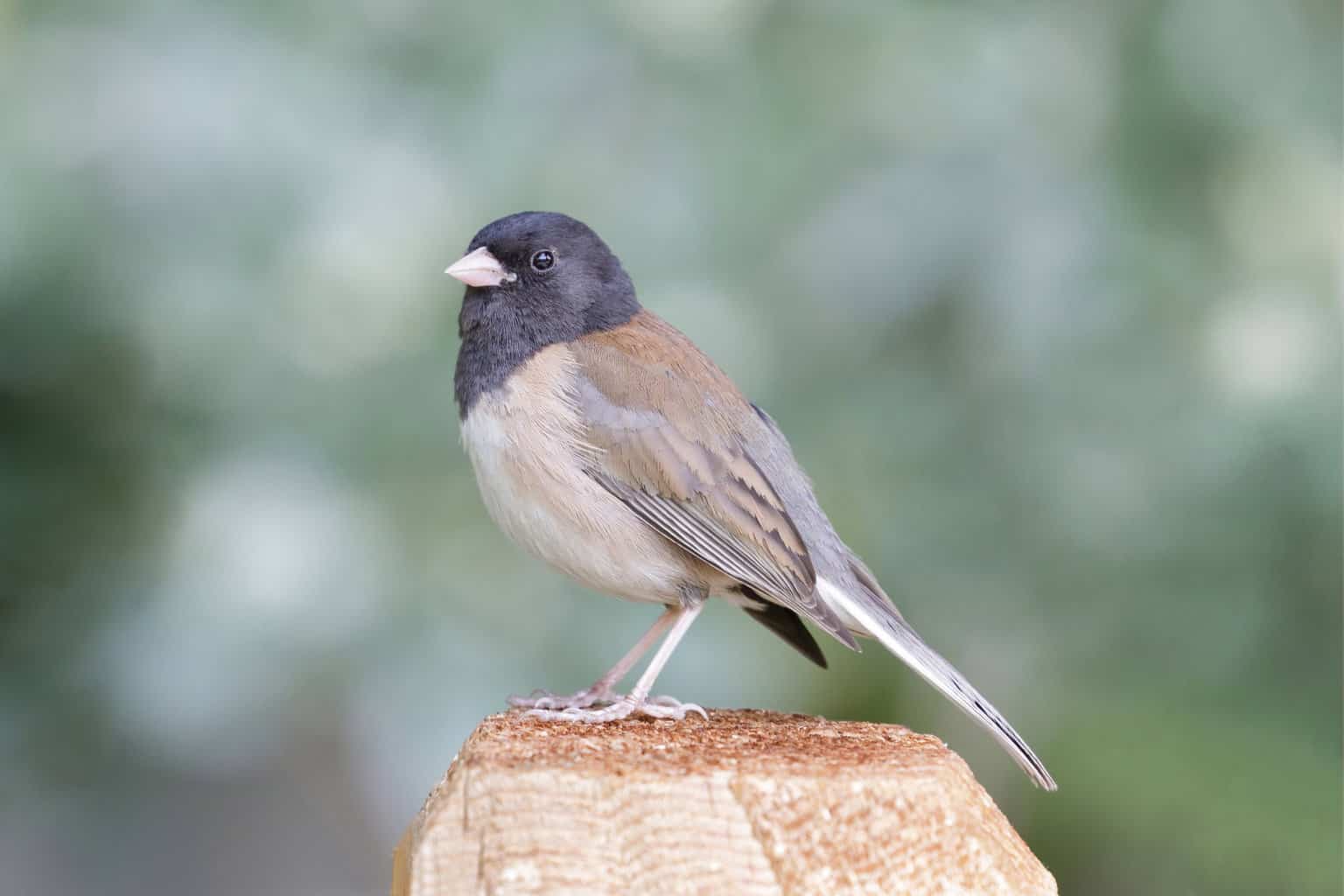
- Scientific Name: Junco hyemalis
- Length: 5.5-6.3 in (14-16 cm)
- Weight: 0.6-1.1 oz (18-30 g)
- Wingspan: 7.1-9.8 in (18-25 cm)
There are six distinct subspecies of dark-eyed Juncos in North America, and Wyoming is one of the few states that can boast five of them!
The Oregon, pink-sided, white-winged, and slate-colored dark-eyed junco are all present during Wyoming’s winters, with the rarer gray-headed, pink-sided, and white-winged subspecies all breeding in the state, too.
Each of these subspecies has a distinct appearance, but where breeding ranges overlap, hybridization can occur.
Dark-eyed juncos are some of the most enthusiastic visitors to backyard bird feeders, and you can help them through the Wyoming winters by offering them peanuts and mixed seeds during the coldest months.
Song Sparrow

- Scientific Name: Melospiza melodia
- Length: 4.7-6.7 in (12-17 cm)
- Weight: 0.4-1.9 oz (12-53 g)
- Wingspan: 7.1-9.4 in (18-24 cm)
The most common sparrow in the United States looks fairly similar to many other brown-streaked species, but luckily, it’s also the most vocal! This means that learning the song sparrow’s call is the easiest way to identify these birds.
Song sparrows are present throughout the year in Wyoming, except in the northeastern corner of the state where they can only be found during the breeding season.
This medium-sized sparrow’s favorite habitat is brushy areas near water, but they can be seen almost everywhere at different times of the year. In towns and cities, scientific studies have shown they adapt their simple song to their noisy surroundings!
Chipping Sparrow
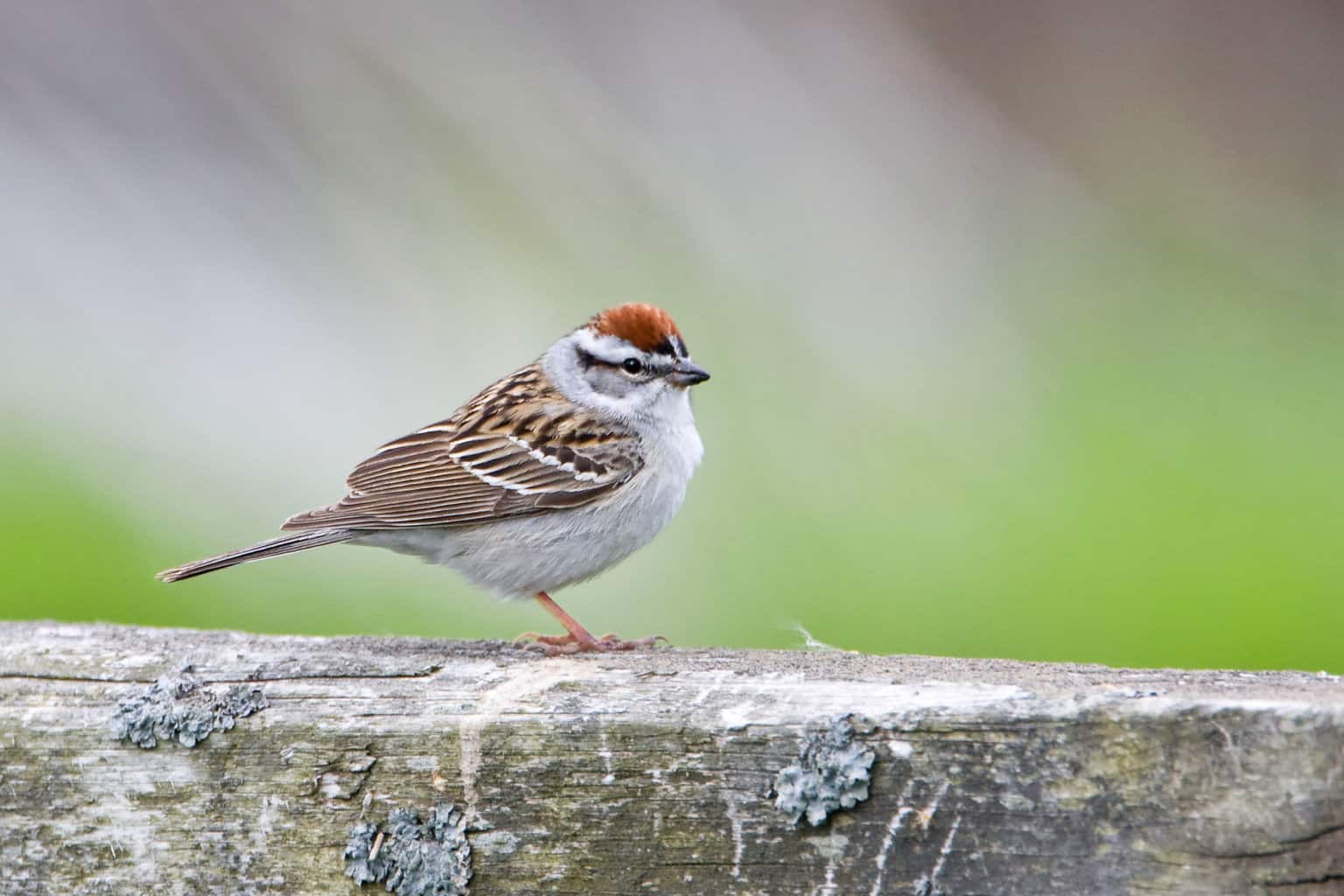
- Scientific Name: Spizella passerina
- Length: 4.7-5.9 in (12-15 cm)
- Weight: 0.4-0.6 oz (11-16 g)
- Wingspan: 8.3 in (21 cm)
Another highly vocal sparrow is the chipping sparrow. The rusty crown and black eye line of this grayish sparrow are their classic field marks, but learning its mechanical trill is a useful way to distinguish it from other Spizella sparrows.
These little birds are only summer visitors in Wyoming when large numbers of them come to breed in open woodlands and suburban parks. They normally nest low down in shrubs and trees, but these quirky birds will occasionally nest among vegetable stands or hanging baskets, too!
They lay up to 7 eggs and have up to 3 broods during the year. No wonder they’re such common birds!
White-crowned Sparrow
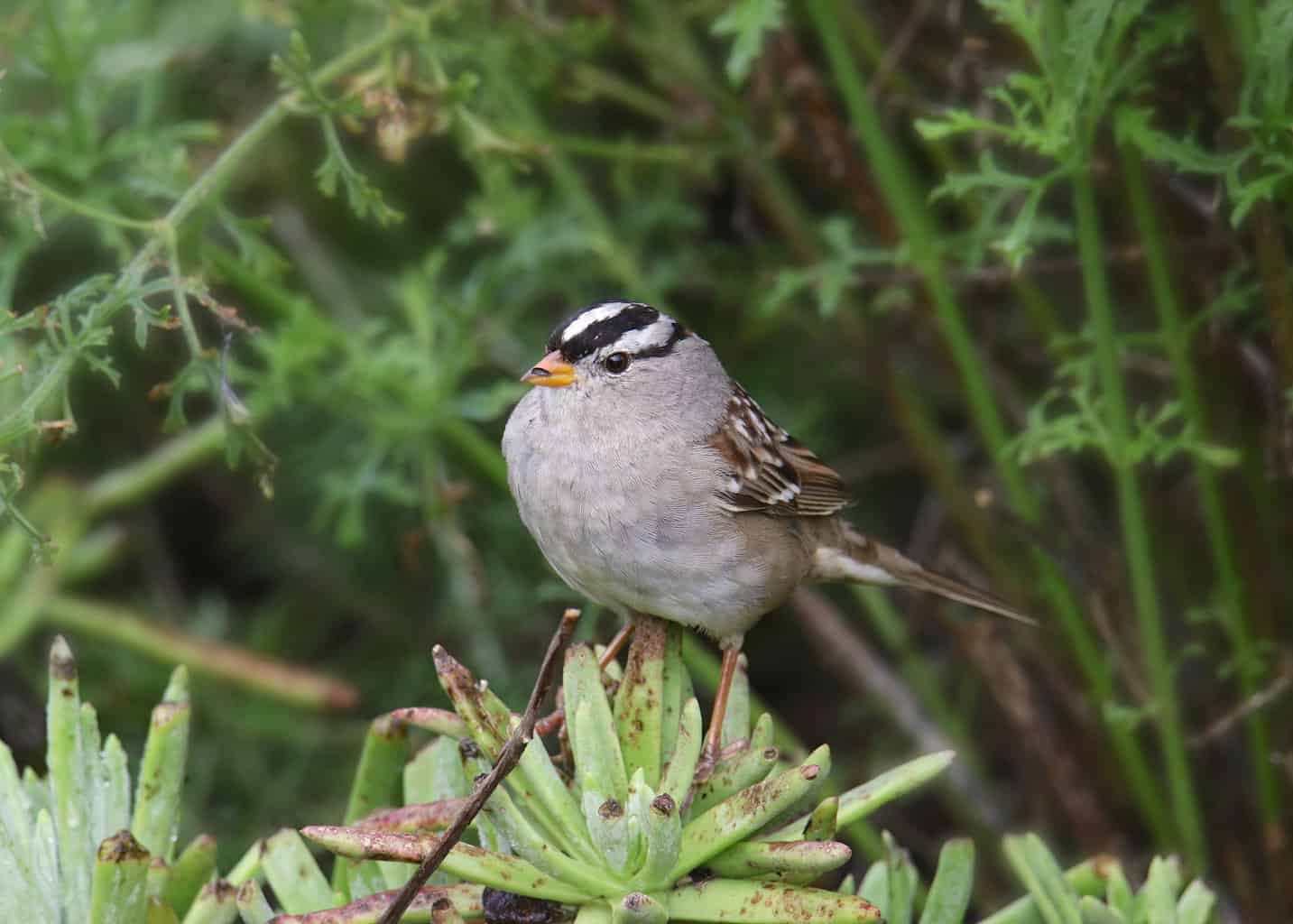
- Scientific Name: Zonotrichia leucophrys
- Length: 5.9-6.3 in (15-16 cm)
- Weight: 0.9-1.0 oz (25-28 g)
- Wingspan: 8.3-9.4 in (21-24 cm)
White-crowned sparrows are easy to recognize by the black and white stripes on their crowns and bright yellow bills.
These medium-sized sparrows have an enormous migratory range that spans from Central America to the Arctic Circle. In Wyoming, their distribution is very regional.
You’ll only find white-crowned sparrows in the southwesternmost corner of the state during winter. In summer, they only nest in the mountainous regions of the west and the south of the state.
They form their nests near the ground in weedy alpine meadows, and their young take a further week or two to hatch after leaving the nest.
Vesper Sparrow
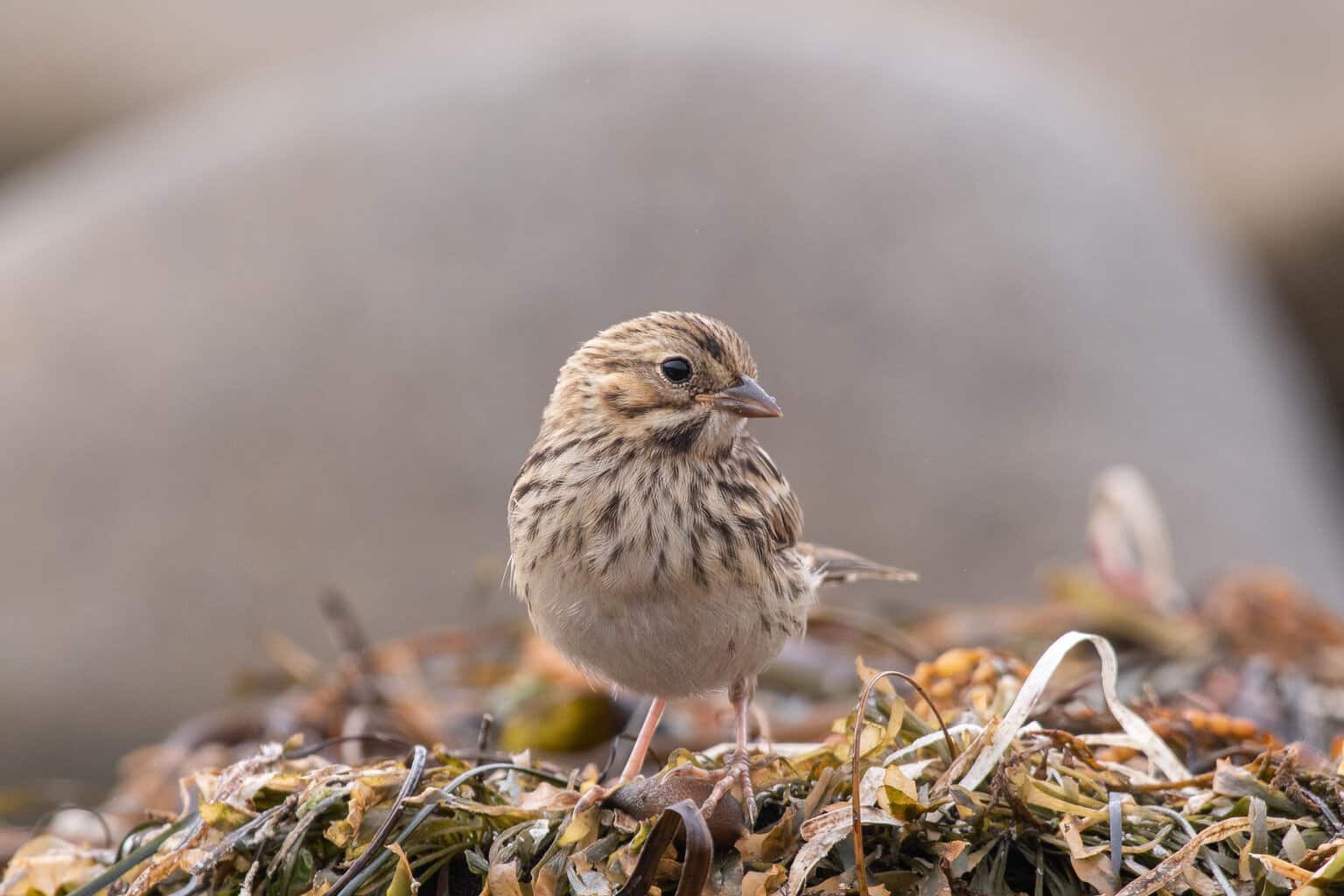
- Scientific Name: Pooecetes gramineus
- Length: 5.1-6.3 in (13-16 cm)
- Weight: 0.7-1.0 oz (20-28 g)
- Wingspan: 9.4 in (24 cm)
The vesper sparrow is a grassland bird that looks like a larger version of the savannah sparrow. They’re gifted with a cheerful, musical trill, and often can be seen perching on top of fences and tree branches.
These largish sparrows can be found throughout Wyoming during the nesting season when they build their nests on the ground out of the grass, tree bark, and moss.
Males like to attract females by jumping in the air with their wings raised and singing loudly!
Brewer’s Sparrow
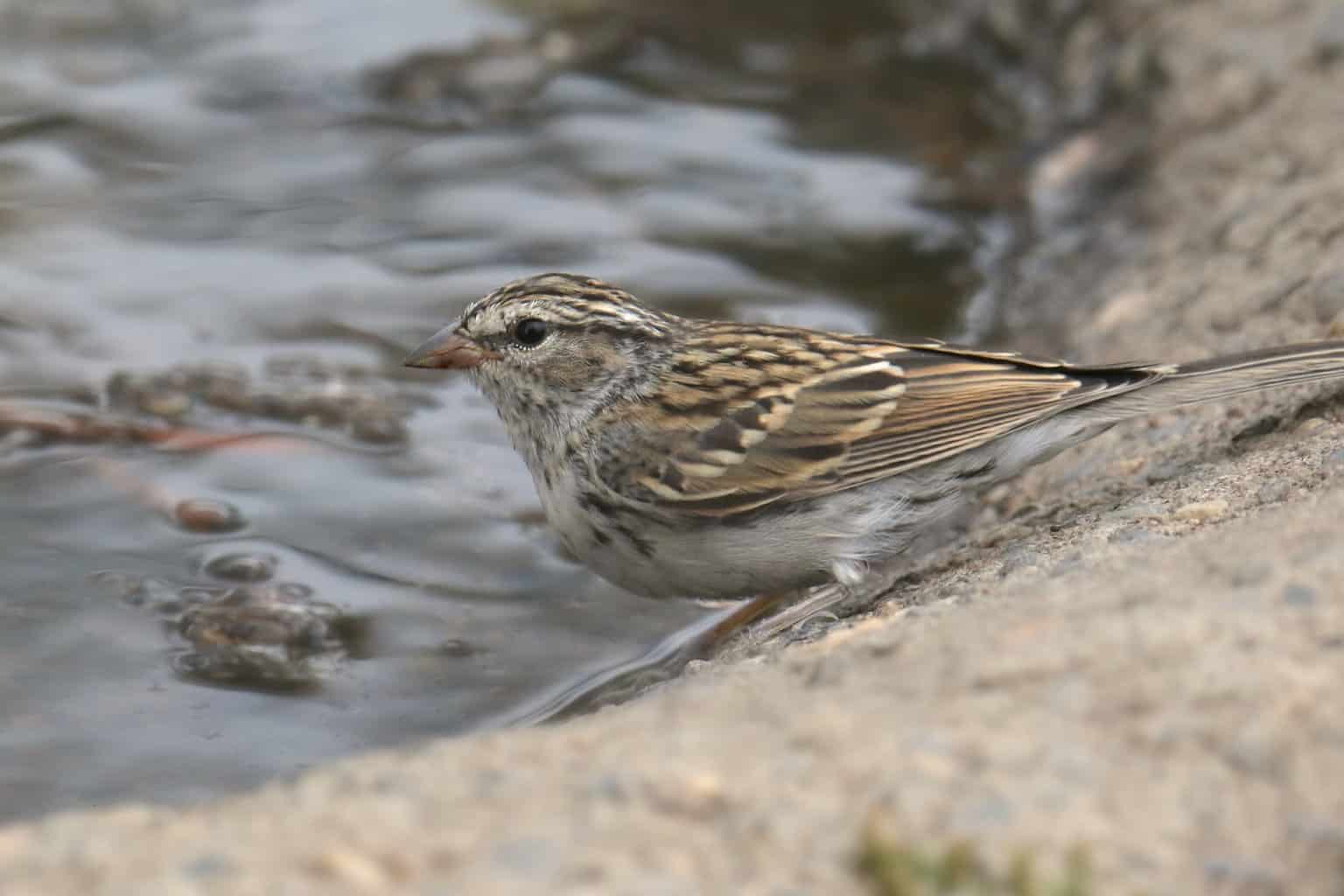
- Scientific Name: Spizella breweri
- Length: 5.1-5.9 in (13-15 cm)
- Weight: 0.3-0.5 oz (11-14 g)
- Wingspan: 7.1-7.9 in (18-20 cm)
Weighing as little as 0.35oz, Brewer’s sparrows are one of the very smallest sparrows in the United States. Although they resemble the clay-colored sparrow that can occasionally be seen here, they are noticeably drabber birds with uniform gray-brown chests.
Wyoming is one of only four states where Brewer’s sparrow can be found nesting everywhere. Although these tiny birds are locally common, they have quite a confined range compared to many sparrows.
What Brewer’s sparrow lacks in size, it makes up for in courage. Amazingly, Brewer’s sparrows can sometimes be seen chasing away large birds of prey from their nests!
Lark Sparrow
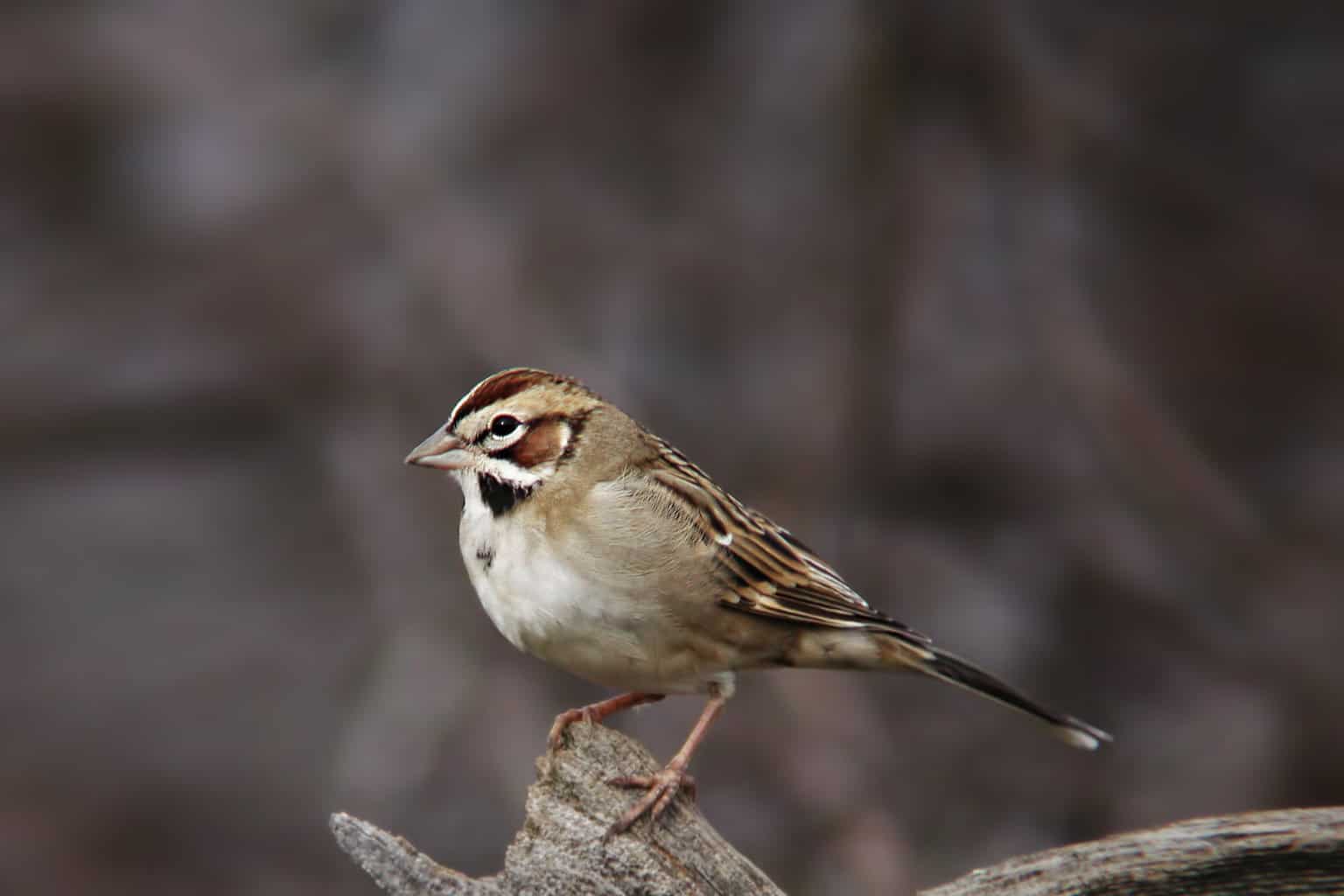
- Scientific Name: Chondestes grammacus
- Length: 5.9-6.7 in (15-17 cm)
- Weight: 0.8-1.2 oz (24-33 g)
- Wingspan: 11.0 in (28 cm)
With its bright white chest and dark brown and white striped head, the large lark sparrow is fairly easy to recognize. They prefer to spend their time in grasslands, with a few trees and scattered shrubs.
Lark sparrows can be found throughout Wyoming during the breeding season when they build their nests on the ground or in low trees.
The male dances around the female for around 5 minutes before mating, and also helps to gather nesting materials. It’s only the female, however, that’s allowed to construct the nest!
Green-tailed Towhee
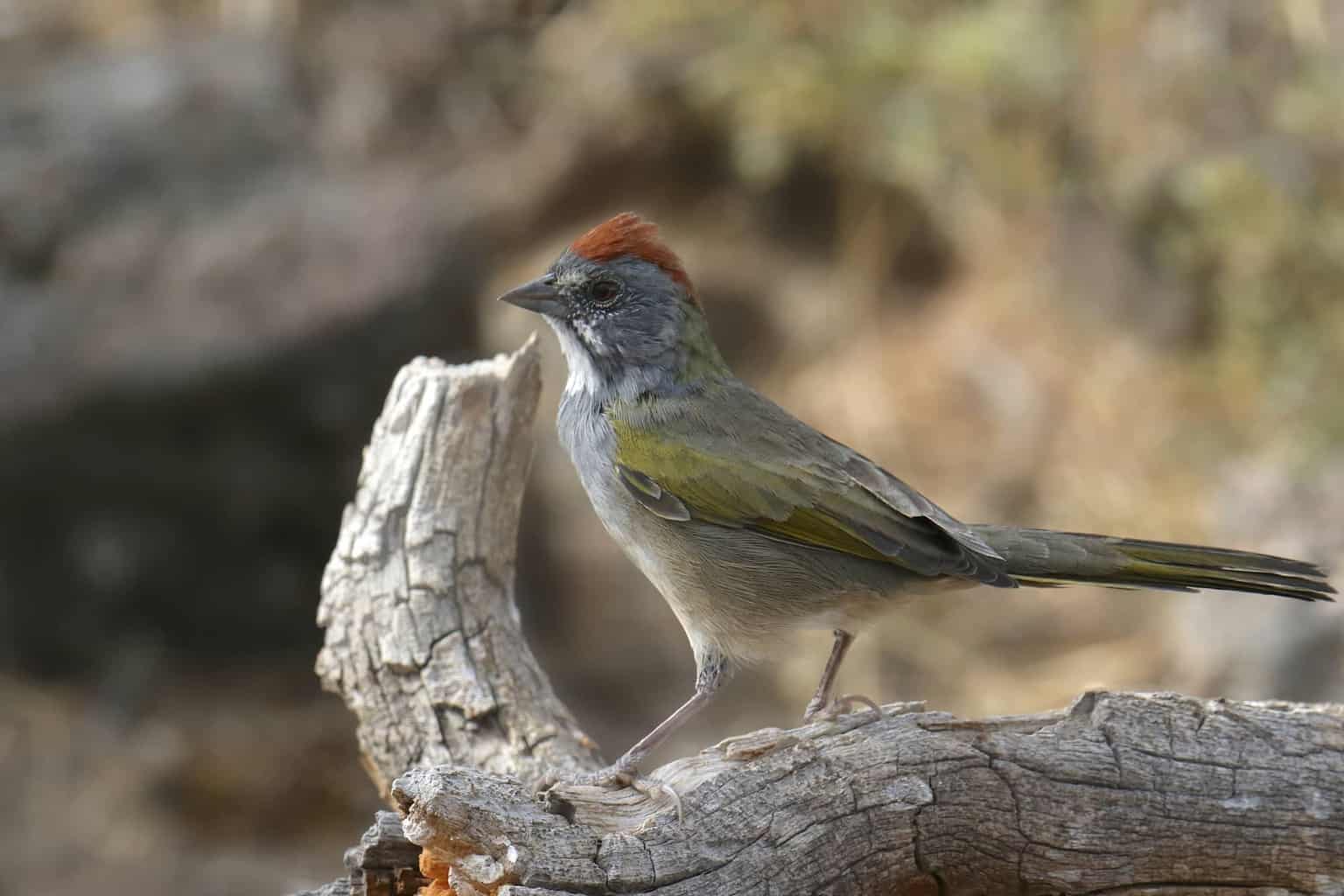
- Scientific Name: Pipilo chlorurus
- Length: 7.25 in (18.4 cm)
- Weight: 0.8-1.4 oz (21.5-39.4 g)
- Wingspan: 9.5-10 inches (23-25cm)
Green-tailed towhees are exotic-looking sparrows of the western mountains. Their olive green-tinted wing and tail feathers, and their rusty crested crowns make them quite different from any other sparrow in our list.
They can be found nesting everywhere except the eastern edge of Wyoming, but they may occasionally be seen in the east during migration.
The best place to see green-tailed towhees is among low shrubs in fairly open landscapes. This bird’s bold whistling trills and cat-like mews may give its presence away even when it remains disguised among vegetation.
Lincoln’s Sparrow
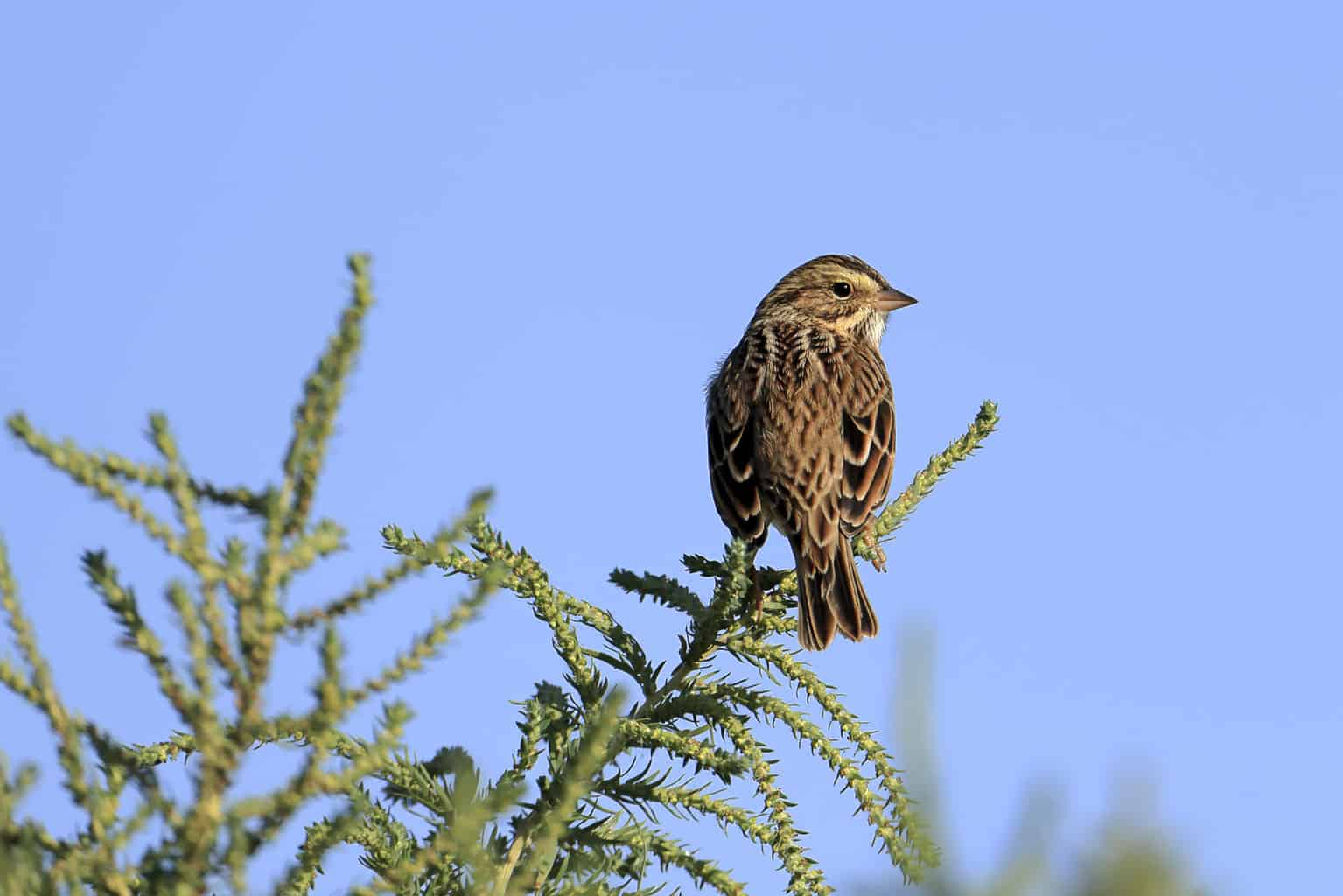
- Scientific Name: Melospiza lincolnii
- Length: 5.1-5.9 in (13-15 cm)
- Weight: 0.6-0.7 oz (17-19 g)
- Wingspan: 7.5-8.7 in (19-22 cm)
Although they look like many other sparrow species with streaked breasts, the long raised feathers on their crown can be a useful field mark of Lincoln’s sparrow.
Other than that, your best way to identify them is by their lovely song: a sweet and soothing mix of trills interspersed with lengthy pauses.
Small numbers of Lincoln’s sparrows can be found breeding throughout the mountainous west of Wyoming during the summer. The best time to see them, though, is during the migration season, when large numbers pass through the state.
This species seems to love staying near water. In the summer you can find them near streams and ditches, but in winter they prefer to congregate in humid forests and tropical jungles.
Savannah Sparrow
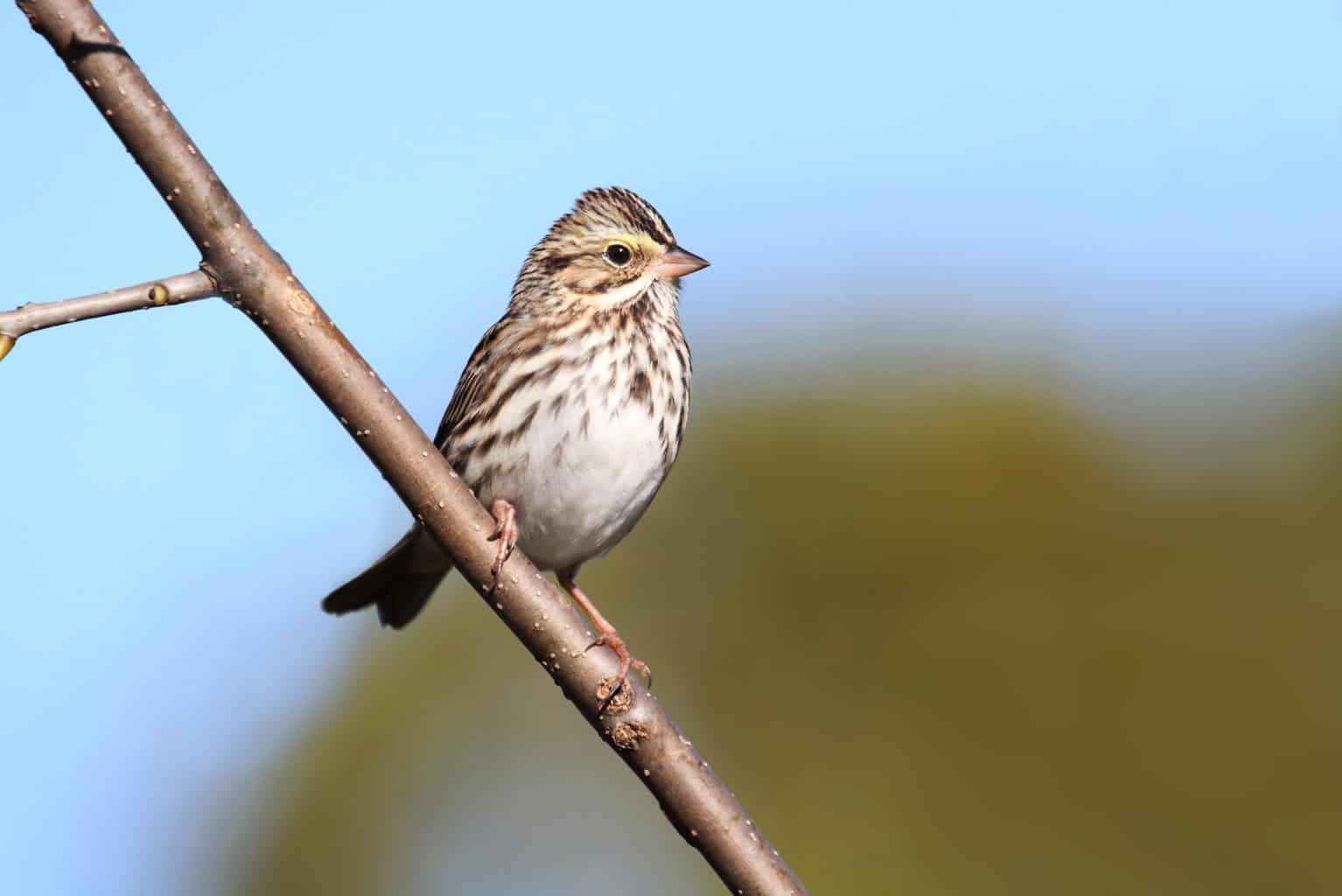
- Scientific Name: Passerculus sandwichensis
- Length: 4.3-5.9 in (11-15 cm)
- Weight: 0.5-1.0 oz (15-28 g)
- Wingspan: 7.9-8.7 in (20-22 cm)
Savannah sparrows are feral, grassland birds, and are not the easiest of sparrows to identify from a distance. A good pair of binoculars, however, will reveal their trademark yellow-tinted facial plumage and pinkish bill.
These medium-sized sparrows can be found breeding throughout Wyoming, except for the lower altitudes of the eastern edge of the state.
Sadly, Savannah sparrows are on the IUCN list of near-threatened bird species. Even if they are still numerous and widespread, ornithologists are concerned about the effects of habitat loss on this bird that requires wild countryside to thrive.
Spotted Towhee
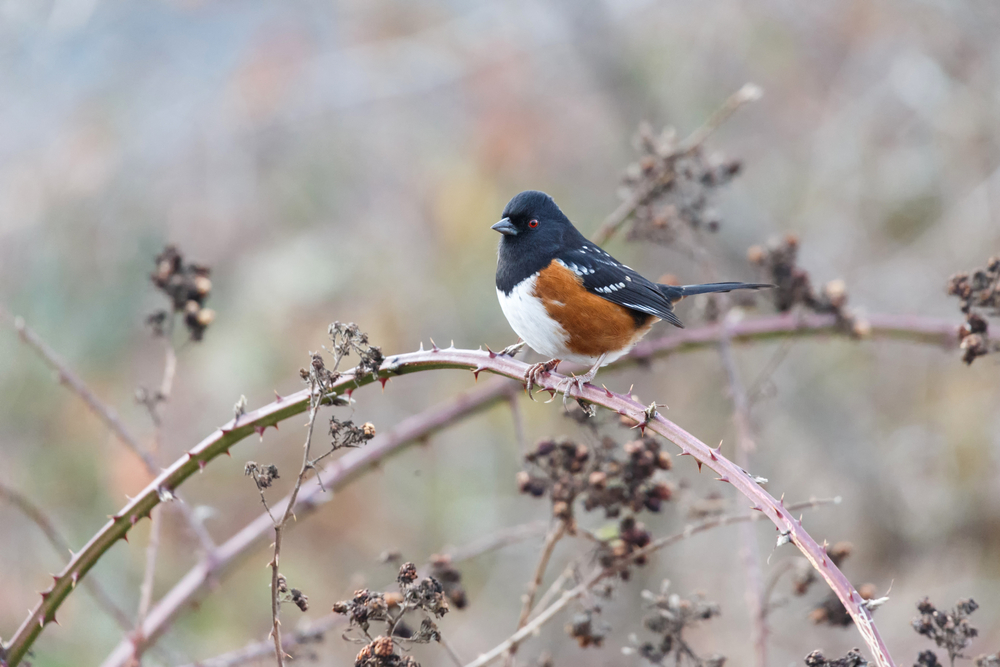
- Scientific Name: Pipilo maculatus
- Length: 6.7-8.3 in (17-21 cm)
- Weight: 1.2-1.7 oz (33-49 g)
- Wingspan: 11.0 in (28 cm)
One of the most beautiful and ornate of all the New World sparrows, the spotted towhee is easily recognizable by its rusty red sides, white chest, red eyes, and white spots on its wings.
With a wingspan of almost a foot across, they are also one of the largest of all sparrow species. You can often see them scratching about in the undergrowth in search of food, much like thrushes do.
Spotted towhees are not as common in Wyoming as in other states further south, but small numbers of them do come to nest here during the breeding season. An even smaller population will sometimes stick out mild winters in the southwestern corner of the state.
Lark Bunting
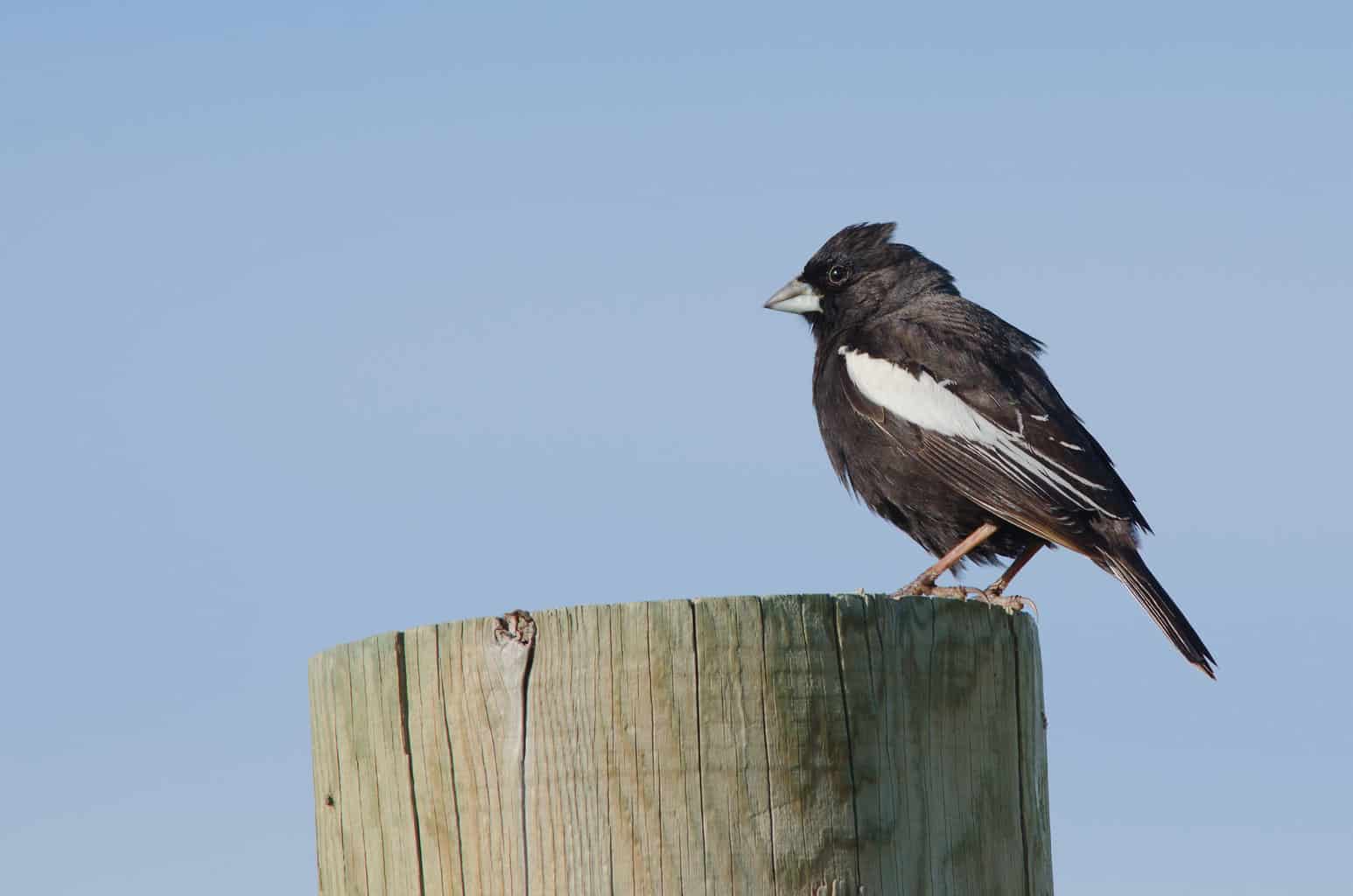
- Scientific Name: Calamospiza melanocorys
- Length: 5.5-7.1 in (14-18 cm)
- Weight: 1.3-1.5 oz (35.3-41.3 g)
- Wingspan: 9.8-11.0 in (25-28 cm)
From one striking-looking sparrow species to another, the male lark bunting is an unusual and impressive-looking member of the family. During the breeding season, he dons almost entirely jet-black plumage, contrasted only by the bright white outer edges of his wings.
After July, the male begins to revert to his winter plumage, which looks more similar to the brown-streaked attire of the female.
Lark buntings can be reliably spotted throughout Wyoming during the summer, except in the southwestern corner of the state where they are rarely seen.
American Tree Sparrow
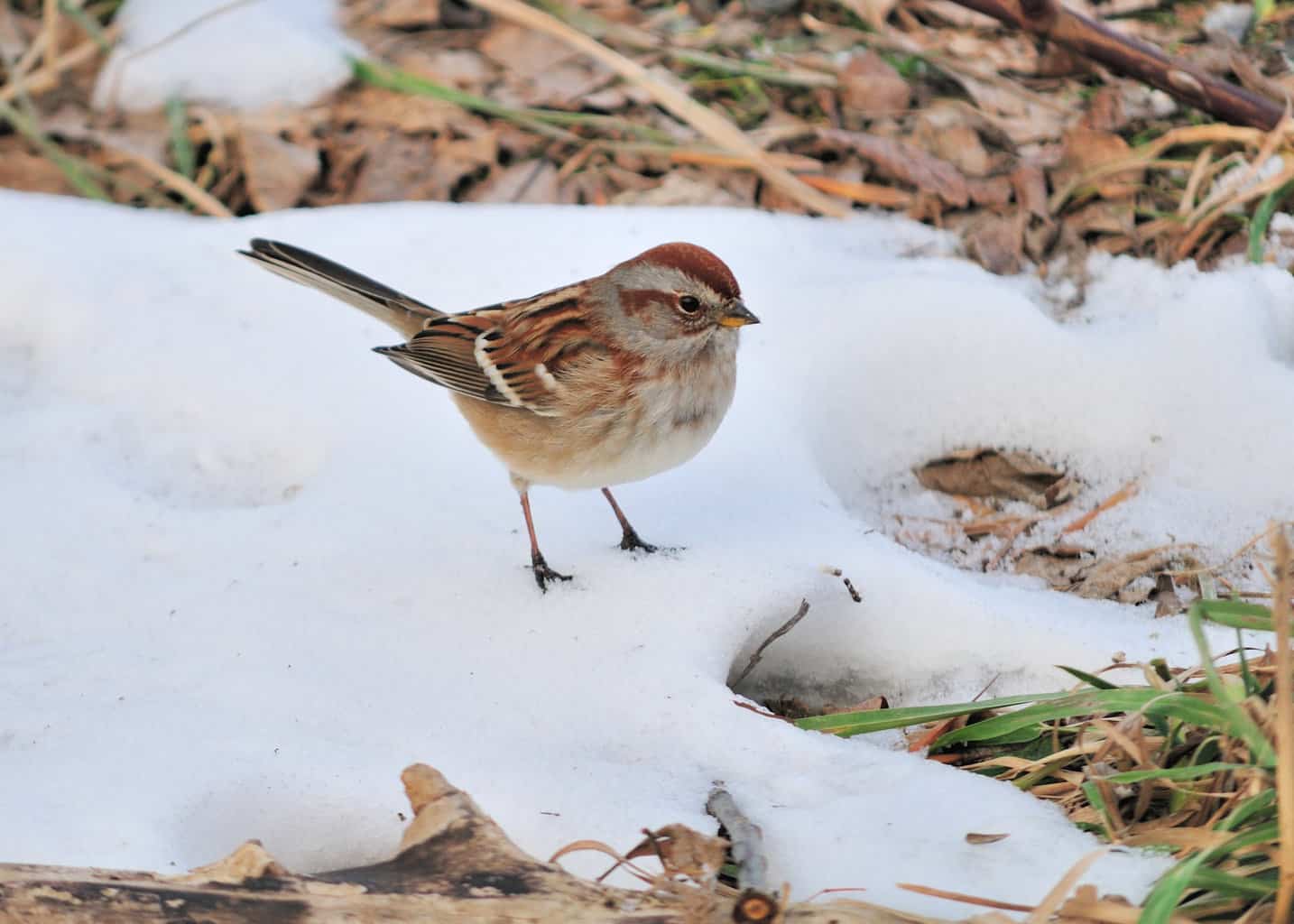
- Scientific Name: Spizelloides arborea
- Length: 5.5 in (14 cm)
- Weight: 0.5-1.0 oz (13-28 g)
- Wingspan: 9.4 in (24 cm)
Believe it or not, Wyoming is merely a wintering ground for the American tree sparrow. Even the cowboy state offers a relatively mild climate compared to its breeding grounds which extend into the arctic circle!
Surprisingly, this species prefers to spend most of its time on the ground! Their name came from European settlers who thought that this bird resembled their native European tree sparrows.
Since it nests in the treeless arctic tundra, nothing could be further from the truth! You can help tree sparrows get through the harsh Wyoming winters by offering them sunflower seeds, cracked corn, and other bird treats from your backyard feeder.
Sagebrush Sparrow
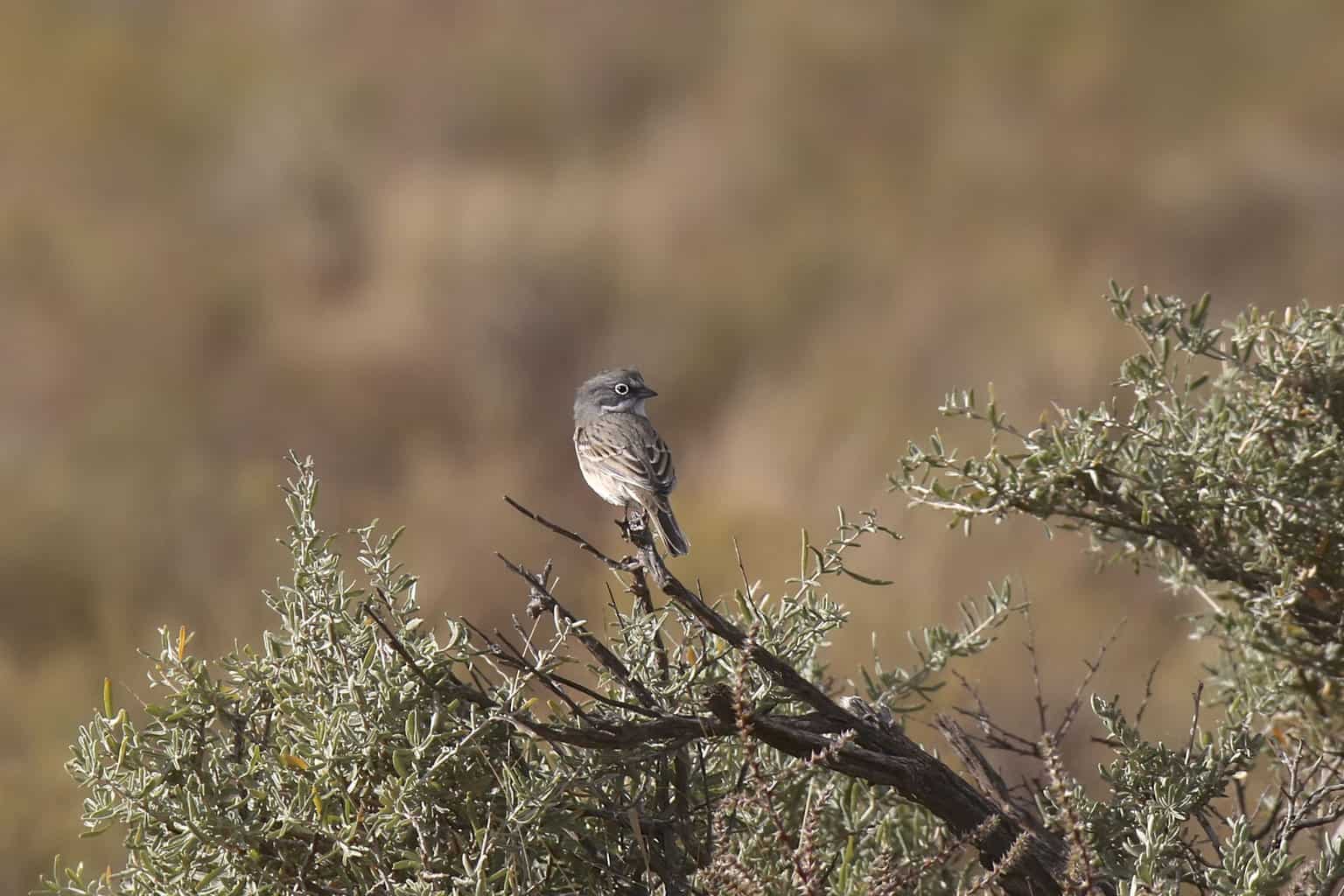
- Scientific Name: Artemisiospiza nevadensis
- Length: 6.25 in – 16 cm
- Weight: 0.7 oz – 20 g
- Wingspan: 8-8.5 inches (20-21 cm)
The sagebrush sparrow is a medium-sized, gray-headed species that can often be seen running between bushes with its tail raised.
Until 2013, the sagebrush sparrow was considered to be the same species as Bell’s sparrow (now recognized as occurring only in the extreme southwest of the US). Since this species is the most widespread, it kept the previous common name.
The sagebrush sparrow does indeed enjoy sagebrush habitats, but this bird can also be found among saltbush, chamise, and various other low-growing shrubs in dry landscapes.
These dryland sparrows are not as common in Wyoming as they are further south, and are altogether absent from the very north and east of the state. While populations are relatively stable, the preservation of scrubland will be essential for this species to prosper for years to come.
Grasshopper Sparrow
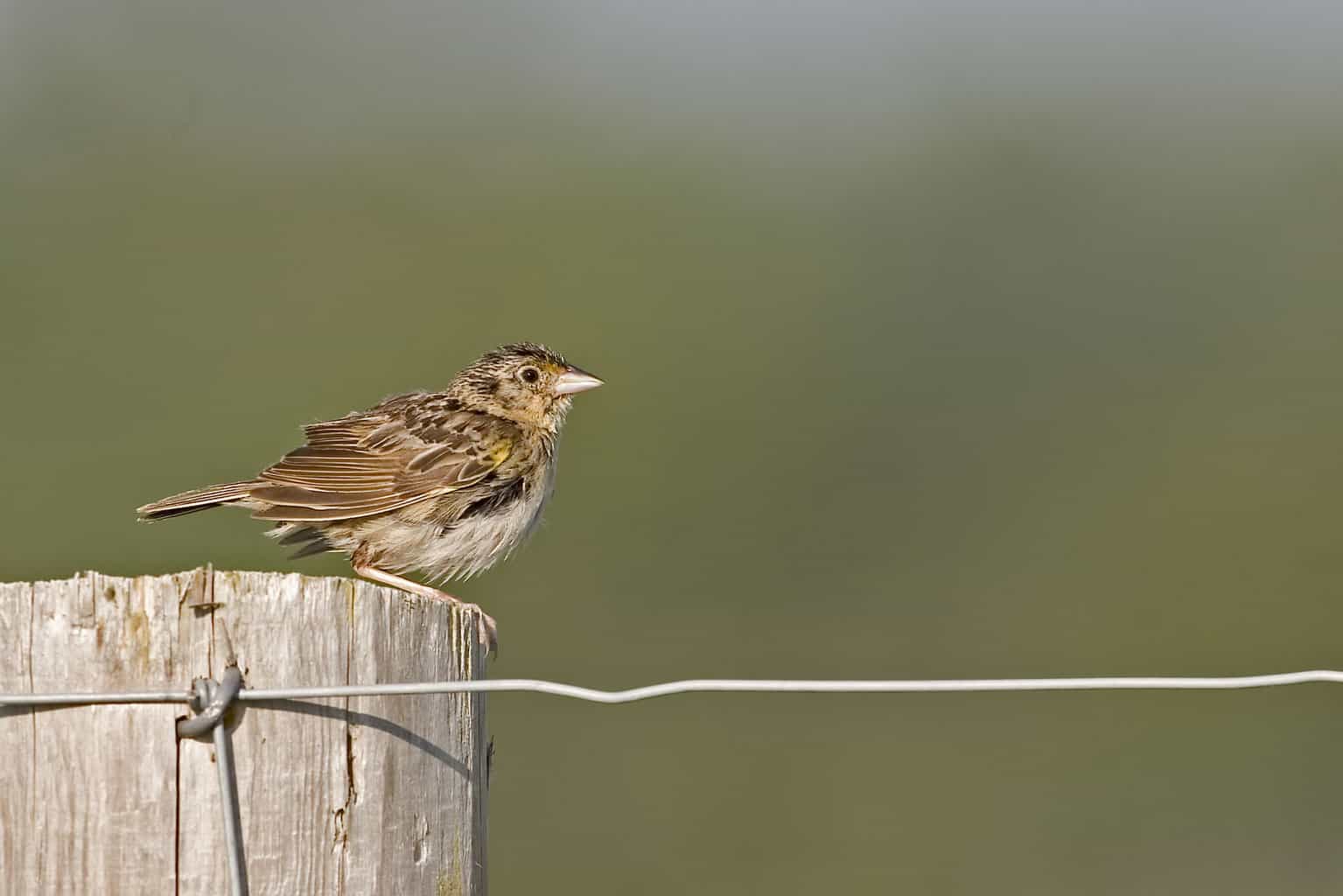
- Scientific Name: Ammodramus savannarum
- Length: 4.3-4.5 in (10.8-11.5 cm)
- Weight: 0.5-0.7 oz (14-20 g)
- Wingspan: 7.9 in (20 cm)
The grasshopper sparrow is the most widespread of the Ammodramus clan of sparrows – tiny birds that tend to remain hidden in remote grassland areas. They tend to prefer drier habitats than most of their relatives and have a large head and short tail.
The grasshopper sparrow not only sounds like a grasshopper but loves to eat them, too! They can be seen shaking grasshoppers before feeding them to their young during the breeding season.
In Wyoming, grasshopper sparrows can be found nesting in large expanses of dry grasslands throughout the state, except in the very south. They generally build a domed nest with an entrance at the side.
Fox Sparrow

- Scientific Name: Passerella iliaca
- Length: 5.9-7.5 in (15-19 cm)
- Weight: 0.9-1.6 oz (26-44 g)
- Wingspan: 10.5-11.4 in (26.7-29 cm)
Fox sparrows are rather unusual members of the family and have no immediate relatives. They are larger than most sparrows and have a speckled breast.
The subspecies that you’ll find in Wyoming is the ‘slate-colored’ fox sparrow – so called for its slate-gray back. The rest of its body is a foxy-tinted brown – faithful to its name.
You’ll only find these birds occasionally breeding in the mountainous west of Wyoming. They tend to spend their winters near the Pacific coast.
Very Rare Sparrows in Wyoming
These last three species typically only occur in small numbers at the very fringes of Wyoming state, so should be considered prized sightings here!
Black-throated Sparrow
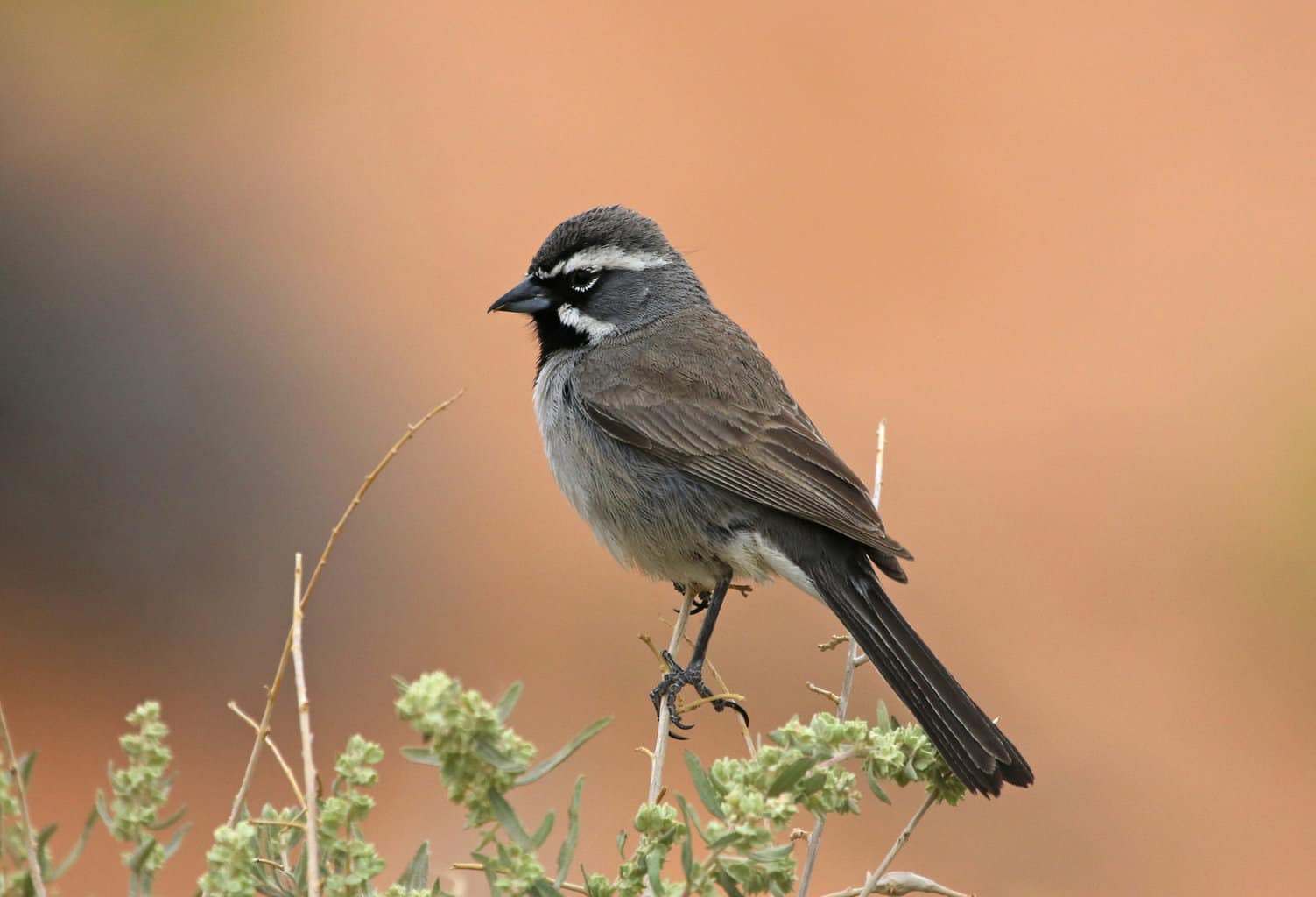
- Scientific Name: Amphispiza bilineata
- Length: 4.7-5.5 in (12-14 cm)
- Weight: 0.4-0.5 oz (11-15 g)
- Wingspan: 7.7 in (19.5 cm)
One of the easiest sparrows to identify, the black-throated sparrow not only has a black neck but also a bold black mask on the face between two white stripes.
These tiny sparrows of the southwestern states enjoy life in the desert and only tend to visit the southwestern corner of Wyoming occasionally during the summer.
Quite a bold bird, this species can often be seen foraging calmly in open ground or perched upon exposed tree or shrub branches.
Baird’s Sparrow
- Scientific Name: Centronyx bairdii
- Length: 5.5 in (14 cm)
- Weight: 0.8 oz (23g)
- Wingspan: 8.5 in (22 cm)
A rather paler cousin of the grasshopper sparrow, Baird’s sparrow can occasionally be found nesting in the eastern regions of Wyoming.
Their presence is very difficult to detect since they are solitary and secretive birds. Learning its clear, tinkling song is one of the best ways to locate and identify it.
Field Sparrow
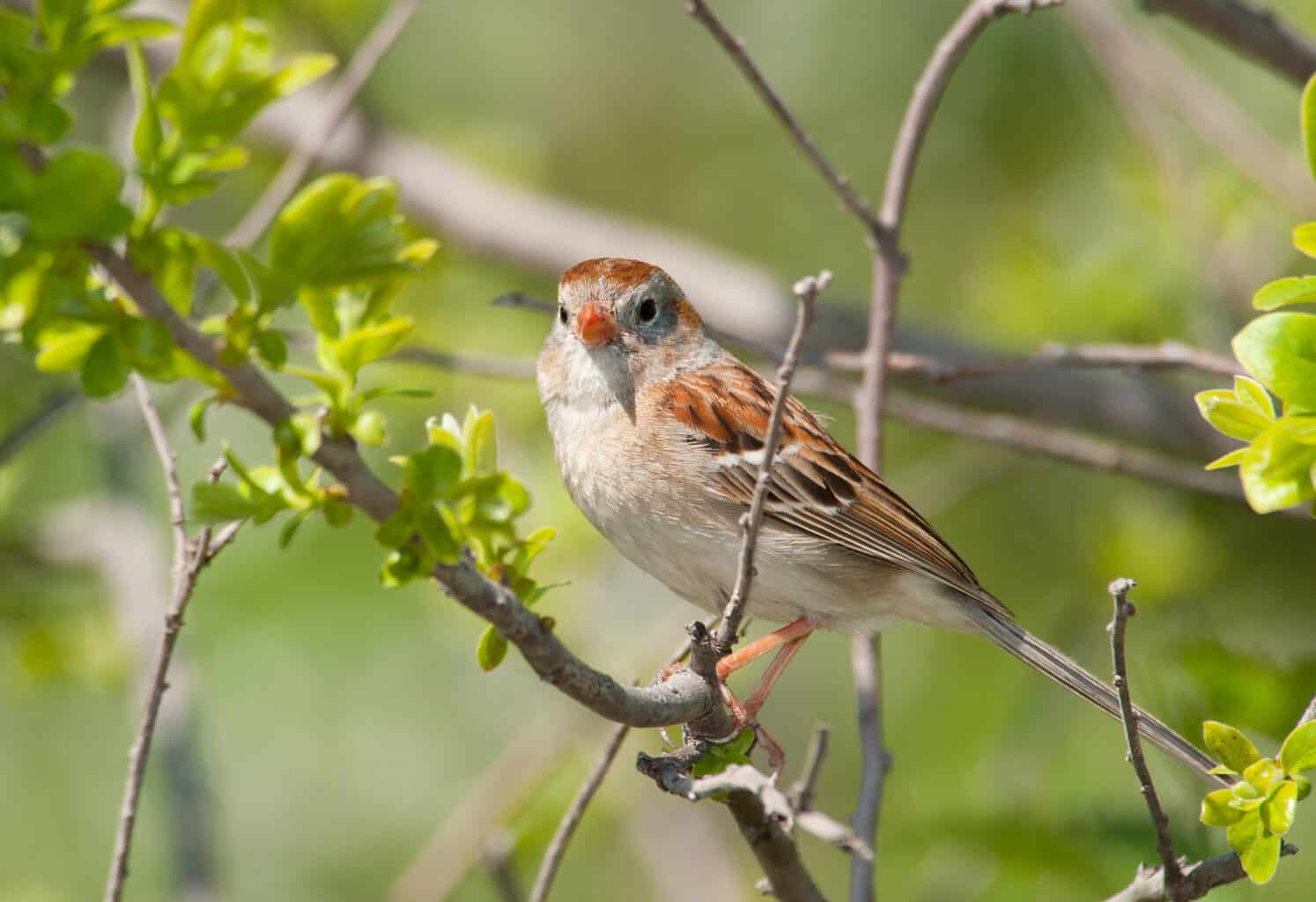
- Scientific Name: Spizella pusilla
- Length: 4.7-5.9 in (12-15 cm)
- Weight: 0.4-0.5 oz (11-15 g)
- Wingspan: 7.9 in (20 cm)
Field sparrows are small, pinkish-brown sparrows. As their name suggests, they prefer life out in the meadows to areas nearby human habitation, and their reclusive nature can make them difficult to spot.
A good way to identify this secretive bird is by its high-pitched trill, often sung in the early morning, that sounds a bit like a bouncing ball coming to a stop!
Although these birds are more common further east, they only tend to show up on the eastern fringes of Wyoming during the breeding season.
Sparrows Passing Through Wyoming During Migration
As well as resident species, there are a couple of other sparrows that can be seen in Wyoming purely during the spring and fall migratory seasons. Although these birds neither stop in Wyoming for the winter nor summer, you may still see them visiting woodlands or backyards on their way through.
White-throated Sparrow (Zonotrichia albicollis)
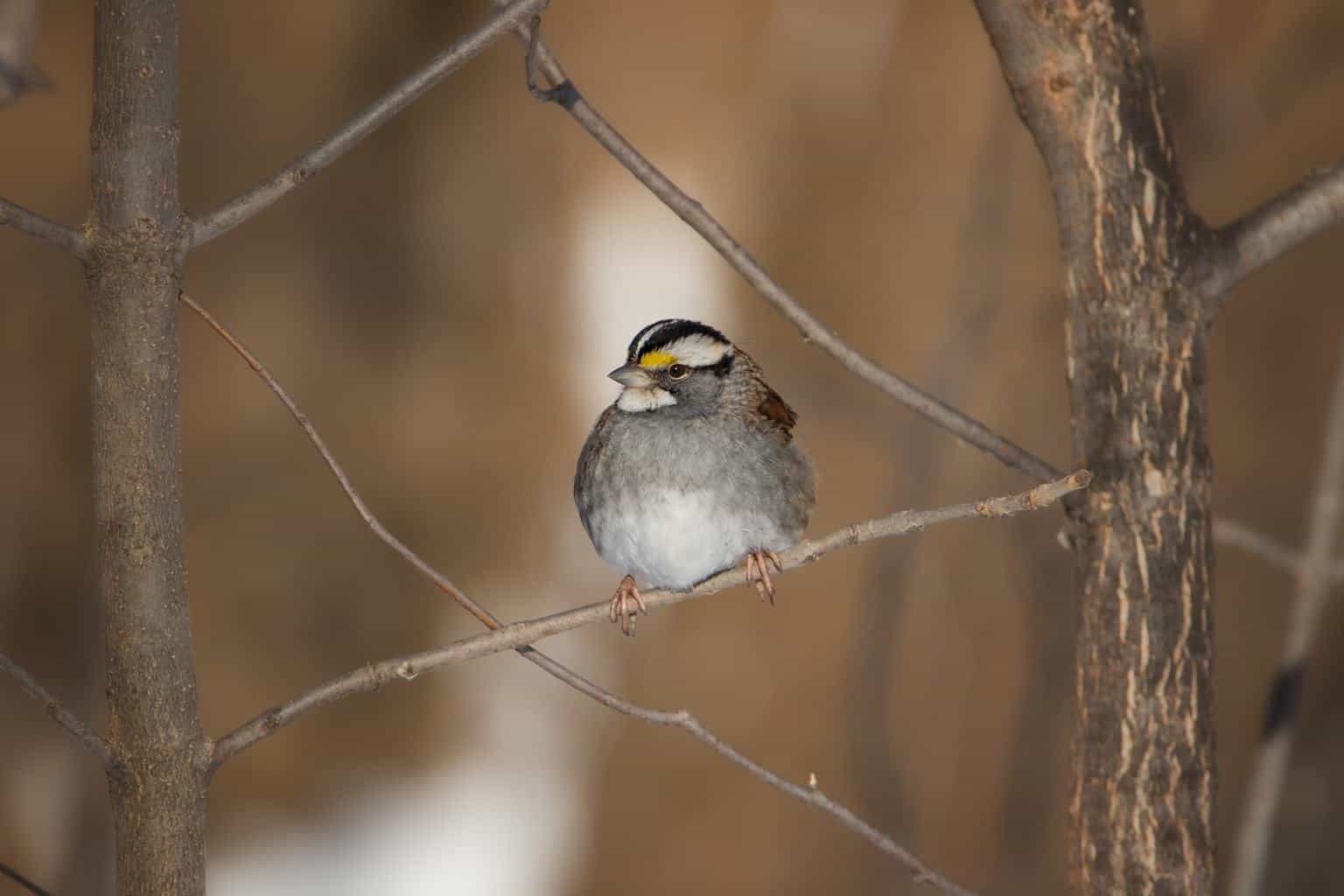
The white-throated sparrow is fairly easy to recognize from their black and white (or sometimes tan) striped head, yellow eyebrows, and white throat. The rhythm of their rather melancholic song can be remembered by the appropriate mnemonic: “Oh Sweet Canada-Canada-Canada”!
White-throated sparrows are more of an eastern bird but may be seen migrating through the eastern half of Wyoming on their way to Canada. You may be able to tempt them to stop off at your backyard or woodland bird feeders with black oil sunflowers seeds and other rich, oily grains.
Harris’s Sparrow (Zonotrichia querula)
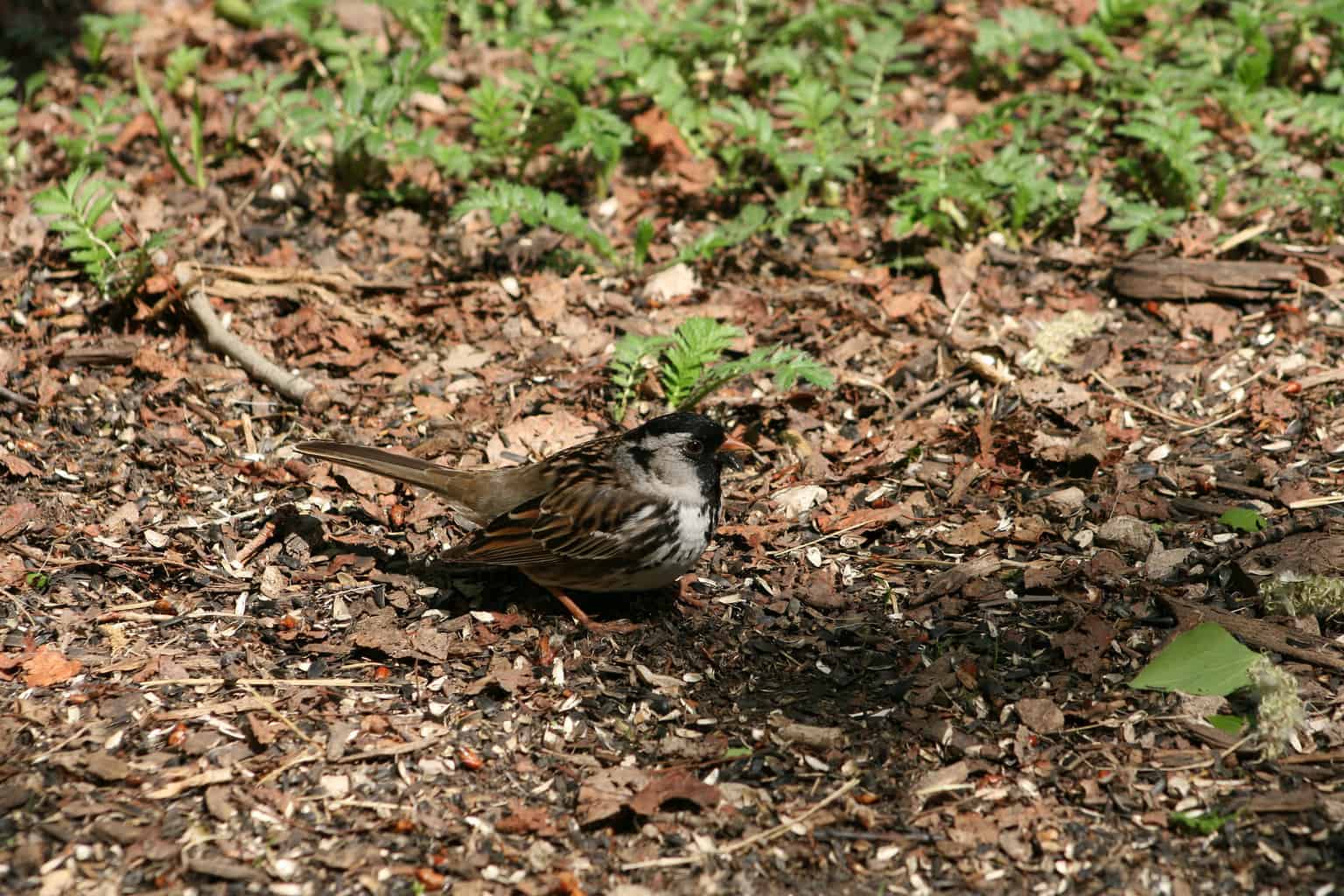
Harris’s sparrow has a black crown and throat that makes them impossible to mistake for any other sparrow species. They have a very narrow longitudinal range in central North America, extending from Texas to Nunavut, Canada.
According to my Sibley Guide to Birds, the only place you’ll see them in Wyoming is in the northeastern corner during migration.
- Sibley Guide To Birds, 2nd Ed
- Sibley, David Allen (Author)
- English (Publication Language)
Last update on 2024-07-26 / Affiliate links / Images from Amazon Product Advertising API
Conclusion
There is a wealth of sparrow species in Wyoming, especially during the breeding season when large numbers of them come to breed in high-altitude landscapes.
Whether you’re watching American tree sparrows feed from your backyard feeders in the winter, or enjoying the sweet song of Lincoln’s sparrow during the summer months, there are plenty of opportunities to encounter these cheerful birds in The Cowboy State.
There’s much more to birding in Wyoming than just sparrow spotting though! That’s why we’ve compiled a guide to some of the most iconic and fascinating of them all. Can you guess which they’ll be? Find out here.

